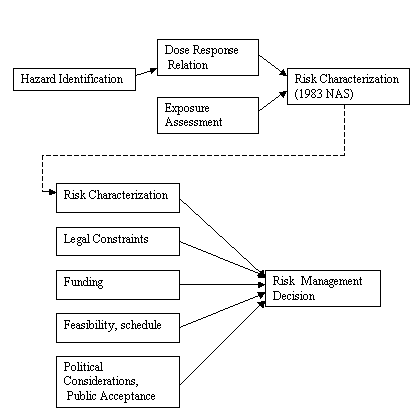
Learning Goals
Introduce Risk Management viz. a viz. Risk Assessment
Describe the changing nature of public involvement in the risk assessment process.
Outline generic steps in public involvement.
(Risk communication is next module)
In Module 8B we discuss how in 1983 the National Academy of Sciences recommended a procedure for risk analysis by the federal government. The widely accepted 1983 NAS paradigm for risk analysis proposed a two stage process, a risk assessment, followed by risk management. Risk assessment was a scientific analysis of the probability and severity of harm (The risk characterization step of the risk assessment is the statement of the probability and severity of the harm). Regarding risks from the releases into the environment, the harm was some adverse effect on human health or the physical environment. Risk management, the decision what to do about the risk, then considered the "non-risk related" decision variables, such as applicable laws, costs, schedules, and "politics." During the risk management stage, the public was informed of the risk managers decisions.
1983 NAS view of the Risk Assessment - Risk Management process:

The risk assessment was kept separate so it would not be influenced by politics or other "non-technical" pressures. The public might be queried during the risk assessment, but only to define parameters such as, personal knowledge of site, demographics, land use patterns, or such. Some public involvement was usually present because it was required by certain laws and public policy. Good public relations practices were also assumed to improve eventual public acceptance. Ideally, however, the engineers and scientists who were performing the risk assessment would be insulated from, or at least not affected by, the public's opinion of the risk.
Many environmental projects, especially waste disposal projects, did not progress, even when the risk assessment stage had demonstrated lack of a significant increase in risk to the public. In 1996 the National Research Council (NRC) (a subdivision of the NAS) produced: Understanding Risk - Informing Decisions in a Democratic Society. The 1996 NRC document proposed a very different risk assessment process, whereby the public stakeholders (affected parties) were included in the risk assessment process and the notion of risk was broadened to include economic threats, aesthetic, or any other concerns that might affect the public. The analysis was to include all these "non-human health risk related" factors. Further, the risk analysis was an iterative process with ongoing communication with the public stakeholders.
So here is the 1996 NRC model. NEXT